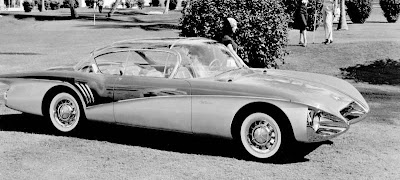Cadillac Eldorado, 1962
The Eldorado model was part of the Cadillac line from 1953 to 2002. The Cadillac Eldorado was the longest running American personal luxury car as it was the only one sold after the 1998 model year. Its main competitors included the Mark Series and the lower-priced Buick Riviera. The name Eldorado was derived from the Spanish words "el dorado", the "gilded one"; the name was given originally to the legendary chief or "cacique" of a S. American Indian tribe. Legend has it that his followers would sprinkle his body with gold dust on ceremonial occasions and he would wash it off again by diving into a lake. The name more frequently refers to a legendary city of fabulous riches, somewhere in S. America, that inspired many European expeditions, including one to the Orinoco by England's Sir Walter Raleigh.
The History
The name was proposed for a special show car built in 1952 to mark Cadillac's Golden Anniversary; it was the result of an in-house competition won by Mary-Ann Zukosky (married name = Marini), a secretary in the company's merchandising department. Another source, Palm Springs Life magazine, attributes the name to a resort destination in California's Coachella Valley that was a favorite of General Motors executives, the Eldorado Country Club. In any case, the name was adopted by the company for a new, limited-edition convertible that was added to the line in 1953.
Although cars bearing the name varied considerably in bodystyle and mechanical layout during this long period, the Eldorado models were always near the top of the Cadillac line. Nevertheless, and except for the Eldorado Brougham models of 1957-1960, the most expensive models were always the opulent, long wheel-based "Series 75" sedans and limousines.
The 1960s
An Eldorado convertible would remain in the Cadillac line through 1966, but its differences from the rest of the line were generally modest. In 1964, probably the most distinctive year during this period, the main visual cue indicating an Eldorado was simply the lack of fender skirts.
1967
The Eldorado was radically redesigned for 1967. Intended for the burgeoning personal luxury car market, it was a "personal" Cadillac sharing the E-body with the Buick Riviera and Oldsmobile Toronado that had been introduced the previous year. Cadillac adopted the Toronado's unique Unified Powerplant Package and front-wheel drive. Like the Toronado, the Eldorado used a standard Cadillac 429 V8 with a modified Turbo-Hydramatic (THM425, based on the Turbo-Hydramatic 400) with the torque converter mounted next to the planetary gearbox, driving it through a metal chain.
Despite sharing a body shell with the Toronado and Riviera, the Eldorado's crisp styling, initiated by GM styling chief Bill Mitchell, was distinctive and unique, with hidden headlights and a long-hood, short-deck look. Performance was sprightly, with 0-60 mph (0-96 km/h) in less than nine seconds, although the standard drum brakes were inadequate (disc brakes were optional in 1967 and standard starting in 1968). Sales were excellent despite high list prices.
For 1968 the Eldorado gained slight exterior changes to comply with new federal safety and emissions legislation, and as with the rest of the Cadillac lineup, a new 472 in³ (7.7 L) V8 engine rated at 375 hp (sea gross). In 1969 it lost its hidden headlamps and picked up as options a halo vinyl roof and later in the model year a power sunroof option. For the 1970 model year, this body style Eldorado introduced the new 500 in³ 8.2 liter V8 engine (rated SAE gross 400 hp/550 ft·lbf in 1970) that would be an Eldorado exclusive until it became standard on all full size Caddies for model year 1975.
Although cars bearing the name varied considerably in bodystyle and mechanical layout during this long period, the Eldorado models were always near the top of the Cadillac line. Nevertheless, and except for the Eldorado Brougham models of 1957-1960, the most expensive models were always the opulent, long wheel-based "Series 75" sedans and limousines.
The 1960s
An Eldorado convertible would remain in the Cadillac line through 1966, but its differences from the rest of the line were generally modest. In 1964, probably the most distinctive year during this period, the main visual cue indicating an Eldorado was simply the lack of fender skirts.
1967
The Eldorado was radically redesigned for 1967. Intended for the burgeoning personal luxury car market, it was a "personal" Cadillac sharing the E-body with the Buick Riviera and Oldsmobile Toronado that had been introduced the previous year. Cadillac adopted the Toronado's unique Unified Powerplant Package and front-wheel drive. Like the Toronado, the Eldorado used a standard Cadillac 429 V8 with a modified Turbo-Hydramatic (THM425, based on the Turbo-Hydramatic 400) with the torque converter mounted next to the planetary gearbox, driving it through a metal chain.
Despite sharing a body shell with the Toronado and Riviera, the Eldorado's crisp styling, initiated by GM styling chief Bill Mitchell, was distinctive and unique, with hidden headlights and a long-hood, short-deck look. Performance was sprightly, with 0-60 mph (0-96 km/h) in less than nine seconds, although the standard drum brakes were inadequate (disc brakes were optional in 1967 and standard starting in 1968). Sales were excellent despite high list prices.
For 1968 the Eldorado gained slight exterior changes to comply with new federal safety and emissions legislation, and as with the rest of the Cadillac lineup, a new 472 in³ (7.7 L) V8 engine rated at 375 hp (sea gross). In 1969 it lost its hidden headlamps and picked up as options a halo vinyl roof and later in the model year a power sunroof option. For the 1970 model year, this body style Eldorado introduced the new 500 in³ 8.2 liter V8 engine (rated SAE gross 400 hp/550 ft·lbf in 1970) that would be an Eldorado exclusive until it became standard on all full size Caddies for model year 1975.





